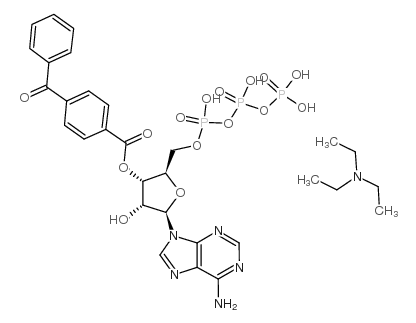2'- AND 3'-O-(4-BENZOYLBENZOYL)-ADENOSINE 5'-TRIPHOSPHATE TRIETHYLAMMONIUM SALT

2'- AND 3'-O-(4-BENZOYLBENZOYL)-ADENOSINE 5'-TRIPHOSPHATE TRIETHYLAMMONIUM SALT structure
|
Common Name | 2'- AND 3'-O-(4-BENZOYLBENZOYL)-ADENOSINE 5'-TRIPHOSPHATE TRIETHYLAMMONIUM SALT | ||
|---|---|---|---|---|
| CAS Number | 112898-15-4 | Molecular Weight | 816.58300 | |
| Density | N/A | Boiling Point | N/A | |
| Molecular Formula | C30H39N6O15P3 | Melting Point | N/A | |
| MSDS | USA | Flash Point | N/A | |
|
Enzymatic conversion of ATP to adenosine contributes to ATP-induced inhibition of glutamate release in rat medullary dorsal horn neurons.
Neuropharmacology 93 , 94-102, (2015) Purine nucleotides, such as ATP and ADP, activate ionotropic P2X and metabotropic P2Y receptors to regulate neurotransmitter release in the peripheral as well as central nervous system. Here we report another type of ATP-induced presynaptic modulation of glut... |
|
|
Crosstalk between purinergic receptors and canonical signaling pathways in the mouse salivary gland.
Cell Calcium 58 , 589-97, (2015) Isolated clusters of mouse parotid acinar cells in combination with live cell imaging were used to explore the crosstalk in molecular signaling between purinergic, cholinergic and adrenergic pathways that integrate to control fluid and protein secretion. This... |
|
|
Potentiation of temozolomide antitumor effect by purine receptor ligands able to restrain the in vitro growth of human glioblastoma stem cells.
Purinergic Signal. 11 , 331-46, (2015) Glioblastoma multiforme (GBM), the most common and aggressive brain tumor in humans, comprises a population of stem-like cells (GSCs) that are currently investigated as potential target for GBM therapy. Here, we used GSCs isolated from three different GBM sur... |
|
|
Functional P2X7 receptors at cultured hippocampal astrocytes but not neurons.
Naunyn Schmiedebergs Arch. Pharmacol. 387(10) , 943-54, (2014) P2X7 receptors have been suggested to be located both on neurons and astrocytes of the central and peripheral nervous systems. In the present Ca(2+)-imaging and patch-clamp study, we reinvestigated these findings on mixed neuronal-astrocytic cell cultures pre... |
|
|
ATP drives lamina propria T(H)17 cell differentiation.
Nature 455 , 808-12, (2008) Interleukin (IL)-17-producing CD4(+) T lymphocytes (T(H)17 cells) constitute a subset of T-helper cells involved in host defence and several immune disorders. An intriguing feature of T(H)17 cells is their selective and constitutive presence in the intestinal... |
|
|
P2X(7) receptor stimulation upregulates Egr-1 biosynthesis involving a cytosolic Ca(2+) rise, transactivation of the EGF receptor and phosphorylation of ERK and Elk-1.
J. Cell Physiol. 213 , 36-44, (2007) The P2X(7) receptor is an ATP-gated ionotropic receptor that is permeable for small cations including Ca(2+) ions. Using 293 cells expressing P2X(7) receptors, we show that the P2X(7) receptor-specific ligand 2',3'-O-(4-benzoyl-benzoyl)-ATP (BzATP) induces a ... |
|
|
Isoproterenol and cAMP block ERK phosphorylation and enhance [Ca2+]i increases and oxygen consumption by muscarinic receptor stimulation in rat parotid and submandibular acinar cells.
J. Biol. Chem. 285 , 13337-48, (2010) Salivary glands are innervated by sympathetic and parasympathetic neurons, which release neurotransmitters that promote fluid secretion and exocytosis when they bind to muscarinic and beta-adrenergic receptors, respectively. Signaling pathways downstream of t... |
|
|
Insulin-degrading enzyme is exported via an unconventional protein secretion pathway.
Molecular Neurodegeneration 4 , 4, (2009) Insulin-degrading enzyme (IDE) is a ubiquitously expressed zinc-metalloprotease that degrades several pathophysiologically significant extracellular substrates, including insulin and the amyloid beta-protein (Abeta), and accumulating evidence suggests that ID... |
|
|
Extracellular ATP protects against sepsis through macrophage P2X7 purinergic receptors by enhancing intracellular bacterial killing.
FASEB J. 29 , 3626-37, (2015) Extracellular ATP binds to and signals through P2X7 receptors (P2X7Rs) to modulate immune function in both inflammasome-dependent and -independent manners. In this study, P2X7(-/-) mice, the pharmacological agonists ATP-magnesium salt (Mg-ATP; 100 mg/kg, EC50... |
|
|
ATP induces NO production in hippocampal neurons by P2X(7) receptor activation independent of glutamate signaling.
PLoS ONE 8 , e57626, (2013) To assess the putative role of adenosine triphosphate (ATP) upon nitric oxide (NO) production in the hippocampus, we used as a model both rat hippocampal slices and isolated hippocampal neurons in culture, lacking glial cells. In hippocampal slices, additions... |